“Who first compared painting and poetry to each other was a man of fine sentiment who had caught in himself a similar effect of both arts. Both, he perceived, represent objects absent as if they were present, semblance as reality; they both delude us, and they both like the illusion. ” G. E. Lessing, Laocoonte or the boundaries between poetry and painting, 1766.
The critical difficulty of diverging on current painting, in the wake of the 1920s, leaving aside the anachronistic question as it is the writer’s belief that Novelty can no longer be considered a yardstick[1], is certainly aware of widespread prosaicity. Contemplating, in the expressive freedom, however factual, a pragmatic and rational artistic research, the effectiveness of this, however, will never be able to do without a sentimental spark, often arising precisely from the practice: it is the protein synthesized by thought and the hand, the essence of Art[2].
With the solo show Why write? Why paint? proposed at SpazioA gallery in Pistoia until 10 January 2020, Luca Bertolo shifts the center of gravity of the pictorial phenomenology on a critical level, as a persistent element in the work both in the creative and fruitful phase and even during the realization phase: the art work, being a manifestation of a language, keeps a concept constant which inevitably overflows and flows into others.
If the literary matrix already stands out from the title, a tribute to the American writer Philip Roth, plastically taken up with a large work evoking the cover of Why Write? Collected Nonfiction 1960-2013, in addition to permeating in all those works including writing (Deleuze, On Poetry, Letter), the reflection to which Bertolo invites does not have, indeed, that tautological rigor of a post-philosophical art[3] but it presses on formal licentiousness, where color is undoubtedly the protagonist, formulating the existentialist question in the only possible non-answer: poetry.
The exhibition takes on the character of a Baudelaireian paraphrase[4] favoring a complete delicacy, without, in the end, denying some melodramatic moments in line with the aforementioned license which evidently affects aesthetics and allegory: the cold but pasty greens of Third Landscape # 21 or Natura Morta or Madonna with Child that finely accompany the pale and lyrical solutions of Appunto, Fiore di Anna # 2 and Lucherino, are contrasted by ironic situations (Why write ?, Untitled 19 # 05, Smiley 19 # 02) or by acute metaphysical reflections such as Hate but above all TODAY, a sort of tombstone of the Present set aside as in an abandoned cemetery (political allusions? Who knows).
The romantic aspect that involves a strong audience interaction, far from being episodic in this period, coined as Relational Romanticism, enriches Bertolo’s search for a conscious and responsible conduct, even ethical, not only in the personification of being painter, also in the will to ask excruciating questions: where is the poetry? Is there still in the world? Did Calliope prostitute herself to vicious and self-centered artists or did she also migrate in the hope of a less worse landing place than the wasteland of origin?
The absence of answers to illogical questions finds critical affirmation in the observation of the Vacuo, physical and temporal, of the current bitter experience, because the poetic and artistic depth is no longer vertical but expansive.
Info:
Luca Bertolo. Why write? Why paint?
until 10th January 2020
SpazioA
via Amati 13, 51100, Pistoia
0573/977354 – info@spazioa.it – www.spazioa.it
[1] Having overcome the formal criteria and facing a historical moment where the availability of images is continuous and incessant, it is absolutely no longer appropriate to bind to structural innovation in the creation of a work of art: the “new” is nothing but a nineteenth-century spectrum which much of the art criticism still pursues. The objective evaluation must shift to the artist, his degree of conscience and the ability to interact with the community.
[2] As proof of the above, Bertolo himself points out a halo of Romanticism in the minimalist art of Sol Lewitt, in an interview in 2010 which is worth reporting on: “In the case of conceptual art, madness lies in the fact of treating ideas as things unrelated to any practice, any interaction with things, with the body, with matter. I am interested in Sol Lewitt when, in his “Paragraphs on Conceptual Art”, he says things like: “Conceptual artists are mystics rather than rationalists. They jump to conclusions that logic cannot reach.” Or: “Rational judgments repeat rational judgments. Irrational judgments lead to new experiences.” It’s so true. It is paradoxical that it has become a common opinion to consider conceptual artists, in general, rationalists, geometers of the spirit, with their schemes … then go to read one of their founding texts and at the first point it is said that conceptual artists are mystical rather than rationalists! Where we talk about logic, but to use it to the limit of the obsession: “Irrational thoughts should be follow absolutely and logically”. Then you understand the greatness of Sol Lewitt … The conceptual dimension must however take into account a form of irrationality. The thing that most distances me from the conceptual way of understanding art is the opinion that the realization dimension is only a by-product of the idea. I repeat, as far as I know, creating a work is the same thing as realizing the idea of a work, both are formed, find a shape, the right shape, during the process. Making art means producing thought, not illustrating it.” Read Artext incontra Luca Bertolo, 2010, http://www.artext.it/Bertolo-Luca.html
[3] Read J. KOSUTH, Art after philosophy: the meaning of conceptual art, Costa&Nolan Ed., Genova, 2000.
[4] The reference is punctual above all in Baudelaire’s critical drafting, although, as in a game of mirrors, it is also valid for poetic production. The opinion of the French author is known on the subject: “I believe in conscience that the best criticism is the one that is delightful and poetic; not a cold and algebraic criticism which, under the pretext of explaining everything, feels neither hatred nor love, and deliberately divests itself of every trace of temperament; but – reflected by the eye of an artist – that which will make us see a painting through the mirror of an intelligent and sensitive spirit, if it is true that a beautiful painting is reflected nature. So the best critical review of a beautiful painting can be a sonnet or an elegy.” See C. BAUDELAIRE, What is the purpose of criticism? In Writings on art. Preface by Ezio Raimondi. Translation by Giuseppe Guglielmi and Ezio Raimondi,Giulio Einaudi Editore, Torino, 1981, pp. 57.
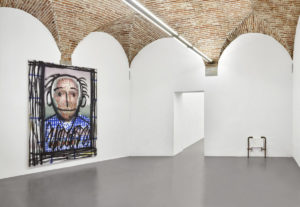 Luca Bertolo, Why Write? Why Paint?, 2019, exhibition view at SpazioA
Luca Bertolo, Why Write? Why Paint?, 2019, exhibition view at SpazioA
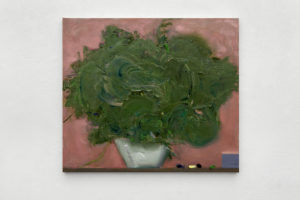 Luca Bertolo, Natura morta / Still Life, 2019, oil on canvas, cm 70 x 80
Luca Bertolo, Natura morta / Still Life, 2019, oil on canvas, cm 70 x 80
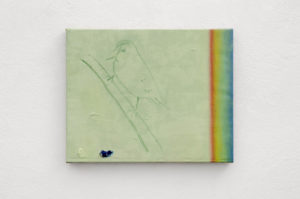 Luca Bertolo, Lucherino, 2019, oil on canvas, cm 40 x 50
Luca Bertolo, Lucherino, 2019, oil on canvas, cm 40 x 50
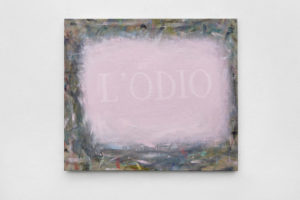 Luca Bertolo, Lucherino, 2019, oil on canvas, cm 40 x 50
Luca Bertolo, Lucherino, 2019, oil on canvas, cm 40 x 50
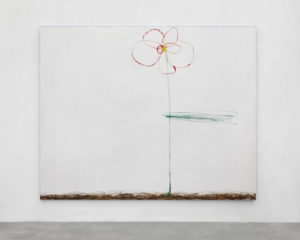 Luca Bertolo, Il fiore di Anna #2 / Anna’s Flower #2,2019, oil and crayon on canvas, cm 200 x 250
Luca Bertolo, Il fiore di Anna #2 / Anna’s Flower #2,2019, oil and crayon on canvas, cm 200 x 250
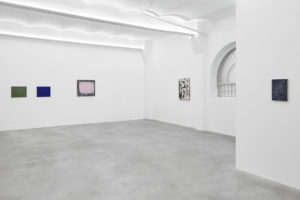 Luca Bertolo, Why Write? Why Paint?, 2019, exhibition view at SpazioA
Luca Bertolo, Why Write? Why Paint?, 2019, exhibition view at SpazioA
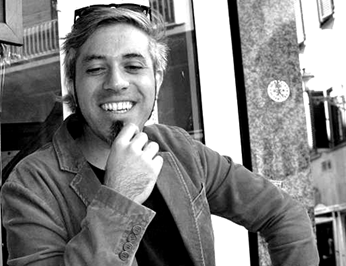
Luca Sposato was born in Tirano, Valtellina, in February 1986, he lives in Prato working in the Florentine metropolitan plain (Pistoia-Prato-Florence). Art historian, critic and curator of art and xylograph. He has curated exhibitions in private galleries, international fairs and public installations, both in Italy and abroad, including a review in historic buildings of Pistoia and the scenography of a musical show at the Textile Museum of Prato. He writes for various magazines both in print and online. His critical research starting from the art graphics, parallel practiced, focuses on the traced, physical and semiotic sign, expanding the study to the time synchronization between past and present, and cultivating curatorial practice as an artistic medium.






NO COMMENT